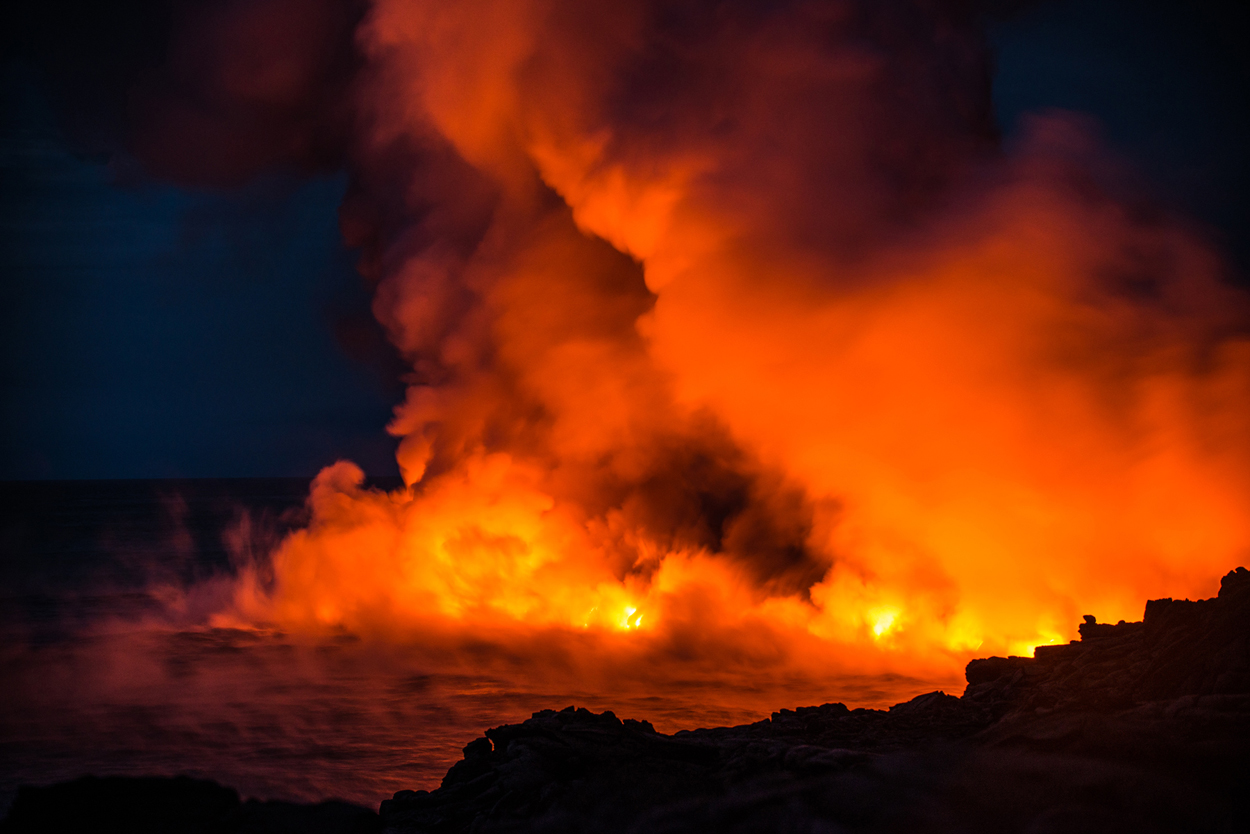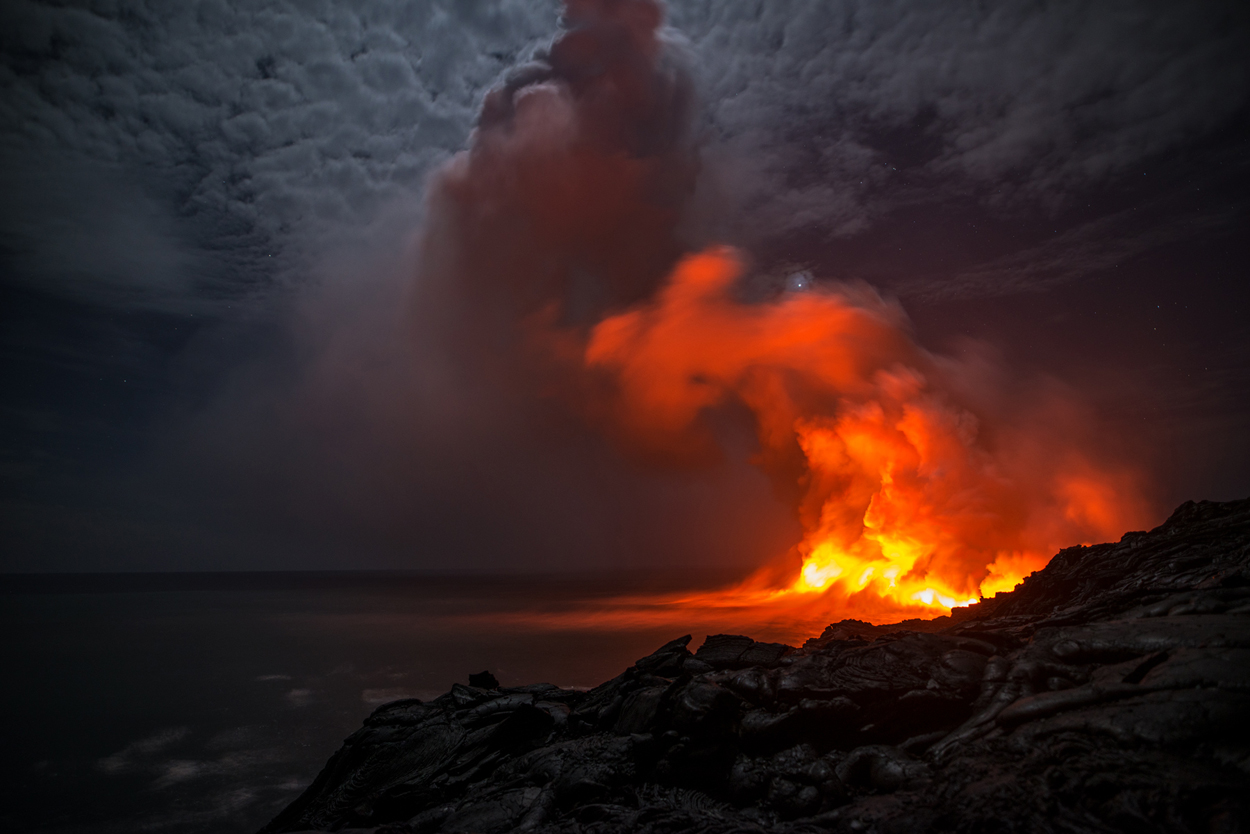Photography is Jack Fusco‘s way to escape the chaos of the world today. You might remember his previous reflection of the desire to always seek new adventures, and his latest trip to Hawaii shows that he hasn’t changed. Together with his buddy Mark Jacobs, Fusco wanted to capture a starlit sky above lava entering the ocean during a tight three-day window. He says it was “easily one of the most exciting and challenging projects” he ever worked on. We sat down with the Californian and asked him what challenges were involved.
The short window of time was definitely the biggest challenge. It rained some 9 inches on our first night and there were calls for rain every hour on the second day. Our backup plan to head to the summit of Mauna Kea also fell through because of 20 fresh inches of snow. So we had to find a way to pivot and make the best use of our time. We always stayed out shooting as long as possible, knowing that just sitting around and waiting for the best conditions wasn’t going to be an option.
As for the exciting part, actually being able to witness the active lava flow was just incredible. I definitely feel very fortunate to have been able to do so. We hiked out to the ocean entry viewing area on the second and third night, and it was impossible to take your eyes off of it while you were there.
Did the project require a lot of preparation?
I had a pretty good idea of the shots I wanted to get before we left, but the weather became the ultimate decider of when and where we would shoot. So, for all the planning that was done before the trip started, I’d say at least half of it changed while we were on location.
Nevertheless, the end result exceeded Fusco’s expectations, even though there were times when the duo questioned if they would be able to get any of the shots they came for at all. It wasn’t until the last night that they saw any significant amount of stars,
There was definitely a bit of stress involved. But to have it all work out in the end was very satisfying.
Do you think a time-lapse is the most ideal way to capture this phenomenon?
Our primary goal was to capture the ocean entry under the stars and to show it in motion. While live video is slowly becoming more and more capable of shooting video at night, I think for the time being this was the best way to do it. There are parts of the time-lapse that seem frantic, but I think it does a good job of portraying the almost violent reaction from the lava entering the ocean and creating that dangerous plume.
Fusco tells Resource Travel that the park service had a roped off area to look at the lava from a safe distance, and that he was committed to respect it. Therefore, despite being near one of mother nature’s most merciless features, he doesn’t think it was a risky or dangerous trip. He admits it would have been great to get a closer view, but “it’s just not worth it.”
We saw a ranger on the first night having to tell people to come back to the other side of the rope every 30 seconds. On the second night, a huge crowd of people decided to head well past the rope to get a better view. It would’ve been easy to follow the crowd, but we stayed put. By going out there, you’re not only endangering yourself, but you also have complete disregard for the park, its rules, and the hardworking people that enforce them.
A second potentially dangerous element of all this was the plume created by the entry, made of sulfuric acid and glass particles. Around midnight on our last night, when we were the only people left in the viewing area, we suddenly noticed a change in the wind. We paid attention to further changes, but quickly noticed how it was definitely shifting toward us. So we quickly grabbed our gear and headed to a safer location.
Better safe than sorry, of course. When we asked Fusco for some more advice for aspiring image makers who feel inspired to capture similar footage, he says he can only stress persistency. He and his partner were both completely exhausted after their trip, but they would have probably missed some of their best shots if they had wrapped up earlier.
Head over to the Macphun blog to see the full trip write-up and a behind the scenes video. You can also find Jack Fusco on Instagram and Facebook. And for all you techies out there, the duo used their Sony A7RII and Nikon D800E bodies with these lenses: Sigma 20mm f/1.4 DG HSM Art Lens, Sigma 24mm f/1.4 DG HSM Art Lens, Sigma 50mm f1.4 DG HSM Art Lens and a Sigma 50-100mm f/1.8 DC HSM. Aside from that, there was a Feisol CT-3442 tripod and a Rhino EVO time-lapse rig. For editing, Fusco used Macphun Luminar, Adobe After Effects and Adobe Premiere.





